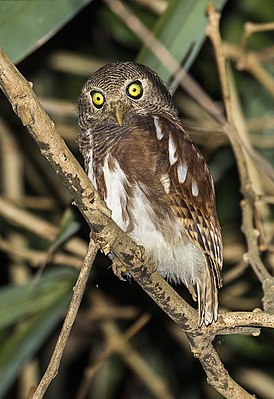Great pygmy owl
| Great pygmy owl | ||||||||||
|---|---|---|---|---|---|---|---|---|---|---|

Great pygmy owl |
||||||||||
| Systematics | ||||||||||
|
||||||||||
| Scientific name | ||||||||||
| Glaucidium castanopterum | ||||||||||
| ( Horsfield , 1821) |
The great pygmy owl ( Glaucidium castanopterum , syn .: Taenioglaux castanopterum ), also called Java pygmy owl , is a species of bird from the family of real owls (Strigidae). The species occurs on Bali and Java . Their range includes subtropical or tropical moist lowland primary or secondary forest up to about 900 m altitude.
description
The pygmy owl is 23 to 25 cm tall. The face is not contrasted in color with red-brown and orange-yellow bands like the entire head, the “eyebrows” are white, the iris and the beak are yellow. There are no eye spots on the neck. The underside is white with red-brown vertical stripes.
voice
The call of the male is described as a series of short trills with a falling pitch.
Way of life
The diet consists of invertebrates .
The breeding season is between February and April, as far as known.
Hazardous situation
The pygmy owl is not considered endangered ( least concern ).
literature
- Th. Horsfield: Transactions of the Linnean Society of London (Trans. Linn. Soc. London), 1821 (1) 13, p. 141.
Individual evidence
- ↑ Owl World
- ↑ Trillerzwergkauz , in Avibase - The World Bird Database
- ↑ a b c d Handbook of the Birds of the World
- ↑ Owlpages
- ^ IUCN Redlist
Web links
- Videos, photos and sound recordings for Glaucidium castanopterum in the Internet Bird Collection
